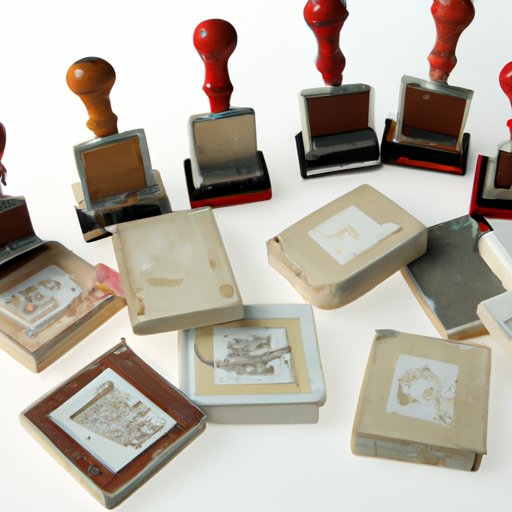
Introduction
If you’re like many people, you may have inherited or stumbled upon a collection of stamps and have wondered if they hold any value. In fact, stamp collecting remains a popular hobby around the world, and certain stamps can be worth significant amounts of money. This guide will provide beginner collectors with an overview of what stamps to collect, how to assess a stamp’s value, expert tips for valuing a collection, and exploring current trends in the stamp market.
A Beginner’s Guide to Collecting Valuable Stamps
While many people may start collecting stamps as a hobby or pastime, others may collect them as a long-term investment. And like most investments, choosing the right stamps to collect is crucial for building a valuable collection.
It’s important to first identify what type of stamps you are interested in collecting. Some collectors focus on collecting stamps from a specific country, while others may choose to collect a particular theme such as sports or animals. Another thing to consider is a stamp’s rarity, age, and condition, as these factors affect a stamp’s value.
The condition of a stamp is frequently graded, and some collectors prefer to only collect stamps in the highest grades possible. A stamp free from defects and damage is known as “unmounted mint,” while a stamp that has been affixed to an envelope is known as “used.” In some cases, lightly used stamps can be worth more than mint stamps, depending on their rarity and demand.
Finally, building a valuable collection takes time and dedication. Collectors should aim to acquire stamps that are scarce or hard to find, and over time, the collection may grow in value as stamps become harder to find or more collectible.
The Top 10 Most Valuable Stamps in History
While rare and valuable stamps can come from any country or era, there are a handful of stamps that stand out among collectors for their historical significance as well as their price tag.
Perhaps the most famous of all stamps is the British Guiana 1c Magenta, which was issued in South America in 1856. With only one known specimen in existence, this stamp has sold for millions of dollars in the past. Another contender is the Treskilling Yellow stamp from Sweden in 1855, which was an error print with a yellow color instead of the typical blue-green. This unique stamp sold for over $2 million in 2010.
Other rare stamps include the 1918 Inverted Jenny stamp from the US, the 1856 Swedish “Tre Skilling Banco,” and the Hawaiian Missionaries stamps from 1851-1866. Collectors should always keep an eye out for these stamps, as they can be worth a fortune if in their collection.
Expert Tips for Valuing Your Stamp Collection
Whether you have inherited a stamp collection or have been collecting stamps for years, it’s important to understand what factors affect the value of a stamp. Rarity, age, condition, and demand all affect a stamp’s worth, but assessing a collection’s value is not a simple task.
One way to evaluate a stamp’s value is to consult a catalog or dealer who can provide up-to-date pricing information. Another option is to conduct extensive research online, which can provide insight into the potential value of a stamp.
When it comes time to sell a stamp collection, collectors should carefully consider their options. Selling a collection to a reputable dealer or auction house is often the best option, as these professionals can accurately assess a collection’s value and market it to the right audience. Proper preservation of a valuable collection is also crucial in maintaining its value.
Uncovering Hidden Gems: How to Spot Valuable Stamps in Your Collection
While certain stamps are known to be valuable due to their rarity, there are many other factors that can bump up the value of a stamp. For example, some stamps with printing errors or unique markings can be worth significantly more than other stamps in the same series.
Collectors should also be aware of stamps that may be more valuable than expected. Rare stamps from less-popular countries, for example, may hold more value due to their scarcity. Additionally, some common stamps that were printed for a short period of time can be worth more than similar stamps printed for a longer period of time.
Overall, keeping an eye out for unique and rare stamps is key to building a valuable collection and spotting hidden gems within your existing collection.
Current Trends in the Stamp Market
Like other collectibles, the stamp market is always evolving, and collectors should stay informed about current trends and popular collecting themes. Genealogy, for example, is a growing trend in stamp collecting as people search for stamps associated with their family history.
Additionally, collecting stamps from emerging regions such as Southeast Asia or Africa can be a smart investment as the value of these stamps increases over time. Collectors should also keep an eye out for limited edition stamps issued by post offices around the world.
Conclusion
Collecting valuable stamps is a hobby that can be both enjoyable and profitable. By understanding what factors affect a stamp’s value, choosing the right stamps to collect, and keeping an eye out for rare and unique stamps, collectors can build a valuable collection over time. With proper care and preservation, a stamp collection has the potential to be a valuable long-term investment.




